Honeywell L5100 User Manual
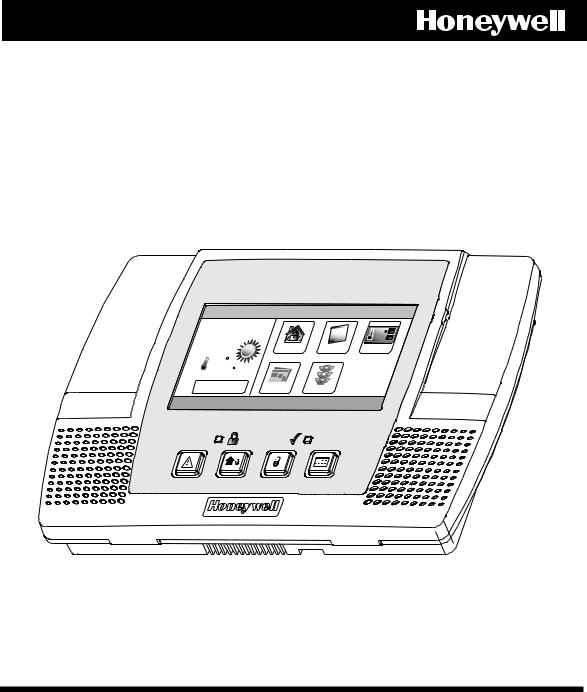
LYNX Touch
Security System
User Guide
Ready To Arm
12:35 PM |
|
|
72 |
October 26, 2011 |
|
|
|
Mostly Sunny |
Security |
Messages |
Automation |
|
|
|
|
68 F |
|
|
|
Feels Like 71 F |
|
|
|
5-Day Forecast |
News |
Traffic |
|
|
|
800-10615 1/12 Rev. A |
LYNX Touch L5100 Series |

Your Honeywell security system is designed for use with devices manufactured or approved by Honeywell for use with your security system. Your Honeywell security system is not designed for use with any device that may be attached to your security system's control or other communicating bus if Honeywell has not approved such device for use with your security system. Use of any such unauthorized device may cause damage or compromise the performance of your security system and affect the validity of your Honeywell limited warranty. When you purchase devices that have been manufactured or approved by Honeywell, you acquire the assurance that these devices have been thoroughly tested to ensure optimum performance when used with your Honeywell security system.
– 2 –

TABLE OF CONTENTS |
|
SYSTEM OVERVIEW.................................................................................................................................. |
5 |
Features................................................................................................................................................... |
5 |
General Operation................................................................................................................................... |
6 |
Quick View of System Functions............................................................................................................ |
9 |
About the Touch screen Control ........................................................................................................... |
10 |
About the Display and Indicators......................................................................................................... |
12 |
Navigating Menus................................................................................................................................. |
14 |
SECURING THE PREMISES .................................................................................................................. |
18 |
System Status........................................................................................................................................ |
18 |
Arming the System................................................................................................................................ |
19 |
Entry/Exit Delays.................................................................................................................................. |
24 |
Disarming the System........................................................................................................................... |
26 |
Bypassing Protection Zones .................................................................................................................. |
28 |
Panic Keys ............................................................................................................................................. |
30 |
Chime Mode........................................................................................................................................... |
32 |
Voice Mode............................................................................................................................................. |
33 |
USER FUNCTIONS ................................................................................................................................... |
34 |
User Access............................................................................................................................................ |
34 |
View Events........................................................................................................................................... |
39 |
Message Recording and Playback......................................................................................................... |
41 |
System Settings..................................................................................................................................... |
43 |
Clock/Calendar ...................................................................................................................................... |
44 |
Automation ............................................................................................................................................ |
44 |
Reminders.............................................................................................................................................. |
55 |
WiFi Configuration ............................................................................................................................... |
62 |
Speaker Phone....................................................................................................................................... |
65 |
Remote Phone Control .......................................................................................................................... |
67 |
Remote Services .................................................................................................................................... |
68 |
Slide Show ............................................................................................................................................. |
69 |
FIRE/CO ALARM SYSTEM...................................................................................................................... |
71 |
General Information.............................................................................................................................. |
71 |
National Fire Protection Association’s Smoke Detector Recommendations....................................... |
72 |
Emergency Evacuation ......................................................................................................................... |
73 |
Congratulations on your ownership of a Honeywell Security System. You have made a wise decision in choosing it, for it represents the latest in security protection technology today. Honeywell is the world's largest manufacturer of security system and millions of premises are protected by Honeywell products.
– 3 –

TABLE OF CONTENTS
SYSTEM FUNCTIONS.............................................................................................................................. |
74 |
Testing the System................................................................................................................................ |
74 |
Maintaining Your System..................................................................................................................... |
77 |
SUMMARY OF AUDIBLE & VISUAL NOTIFICATIONS................................................................... |
79 |
System Displays .................................................................................................................................... |
80 |
Zone Status Icons .................................................................................................................................. |
80 |
REGULATORY AGENCY STATEMENTS ............................................................................................. |
82 |
OWNER’S INSURANCE PREMIUM CREDIT REQUEST.................................................................. |
85 |
SERVICING INFORMATION.................................................................................................................. |
86 |
LIMITATIONS OF THIS ALARM SYSTEM.......................................................................................... |
87 |
INDEX.......................................................................................................................................................... |
93 |
TWO YEAR LIMITED WARRANTY ....................................................................................................... |
95 |
– 4 –

SYSTEM OVERVIEW
Features
General Information
This system offers you three forms of protection: burglary, fire, and emergency, depending on the configuration of your system. The system consists of a touch screen control for system operation, various wireless sensors that provide perimeter and interior burglary protection, and optional smoke or combustion detectors to provide early fire warning. In addition, optional wireless keypads or key fobs may have been installed to allow you to control the system away from the touch screen control. The system may also be used as a speaker phone. The system monitors protection zones and system status, displays appropriate information on the touch screen display, and initiates appropriate alarms. Your system may also have been programmed to automatically send alarm or status messages over the phone lines or via the cellular/GSM network or the internet to a central alarm monitoring station, and may also be capable of two-way voice communication with the central station.
IMPORTANT SECURITY NOTICE
Your key fob is similar to your keys or access card. If lost or stolen, another person can compromise your security system. Immediately notify your Dealer/Installer of a lost or stolen key fob. The Dealer/Installer will then remove the key fob programming from the security system.
The user features of this security system are listed below. Ask your installer which features have been programmed for your system.
•Stay and Away arming modes: By using these modes you can protect either the perimeter only, or the entire premises.
•Panic key functions: A designated key allow you to manually activate fire, medical emergency, or silent police alarms. Refer to the Panic Keys section for detailed information.
•Follow me reminder announcements: Allows the panel to dial a number that you have specified, at a programmed day/time and deliver a message programmed by your installer.
•Real-time clock: Touch screen displays current date and time. Refer to the Clock/Calendar section for procedures for setting the time.
•Message center: The system allows recording and play back of brief voice messages. Refer to the Recording/Playback Messages section for procedures.
•Two-way voice: Allows the central station to listen, talk to or conduct two-way conversations with individuals on the premises Refer to the Two-Way Voice section for detailed information.
•Phone Control: Provides a remote interactive phone capability that permits access to the security system from any off-site touch-tone telephone. Refer to the Remote Phone Control Feature section for detailed information.
•Speaker Phone: The system is capable of operating as a speaker phone allowing hands free telephone conversation. Refer to the Speaker Phone Feature section for detailed information.
•Security Codes: The system is capable of supporting an Installer code, Master user code and 14 additional User codes including Babysitter and Duress codes. Refer to the Security Codes section for detailed information.
–5 –

SYSTEM OVERVIEW
Features
•Device activation: Allows you to send “Follow-Me” or e-mail messages, as a result of a system event such as an alarm or trouble condition. Refer to the Rules section for detailed information.
•Schedules feature: Allows you to schedule the automatic activation or deactivation of program events (e.g. alarm clock, reminder, and latch key). Refer to the Schedules section for detailed information.
•Text Message center (Requires TotalConnect Service): The system allows you to send and receive text messages. Refer to the Text Message Center section for detailed information.
•Web content (Requires TotalConnect Service): The system allows you to view and display web content including weather, news and traffic reports. Refer to the Web Content section for detailed information.
Zones
Your system's sensing devices have been assigned to various "zones." For example, the sensing device on your entry/exit door may have been assigned to zone 01, sensing devices on windows in the master bedroom to zone 02, and so on. These numbers appear on the display when an alarm or trouble condition occurs.
Fire Protection
The fire protection portion of your security system (if used) is always active and will sound an alarm if a fire condition is detected. Refer to the Fire Alarm System section for important information concerning fire protection, smoke detectors and planning emergency exit routes from the premises.
Carbon Monoxide
The carbon monoxide (CO) portion of your security system (if used) is always active and will sound an alarm if a CO condition is detected. Refer to the Fire Alarm System section for more information.
Burglary Protection
Your system provides two modes of burglary protection: STAY and AWAY. STAY mode protects the perimeter only, allowing you to freely move inside the premises. AWAY mode protects the entire system. Both modes provide an entry delay time that allows you to reenter the premises without setting off an alarm. For additional security, you can turn the entry delay off when arming the system. Refer to the Arming the System section. The system also allows you to bypass selected zones before arming the system, if desired. Refer to the Bypassing Protection Zones section. The system also provides a Chime mode, for alerting users to the opening of protected doors and windows while the system is disarmed.
You must arm the burglary protection portion of your system before it will sense burglary alarms. Refer to the Arming the System section for detailed procedures and information.
– 6 –

SYSTEM OVERVIEW
General Operation
Security Codes
At the time of installation, you were asked to provide a personal 4-digit security or “Master User” code. You must enter the user code when arming and disarming the system, and when performing other system functions. As an additional security feature, other users who do not need to know your code can be assigned up to 14 different security codes. Refer to the Security Codes section for procedures on adding security codes to the system.
Alarms
When an alarm occurs, the LYNX Touch internal sounder will sound for about 15-seconds, and the touch screen displays the zone(s) causing the alarm. After 15-seconds, the internal sounder stops temporarily and voice announcements of the zones in alarm begins. When these zones have been announced, the internal sounder sounds again and the cycle repeats itself, until the system is disarmed or until alarm bell timeout occurs. If your system is connected to a central monitoring station, an alarm message will be sent. To stop the alarm sounding, simply disarm the system. The zone(s) causing the alarm remain displayed indicating memory of alarm. Refer to the Disarming the System section for information about clearing the memory of alarm display
Two-Way Voice Feature
The control supports voice dialog between an operator at the central station and an individual at the premises. This feature allows the central station to listen, talk to or conduct a two-way conversation with an individual(s) at the premises and allows the operator to gather information about the nature and location of the alarm that may be helpful in responding to police or rescue departments. If the Two-way Voice Feature has been programmed and an alarm condition is detected, the system sends an alarm message to the central station. After acknowledgement is received, a “listen in to follow” message is sent to the central station. In response to this message, the central station operator can enter commands that allow him to initiate a 5-minute voice session.
If a subsequent security zone is violated during a voice session, the session will continue and the alarm will be buffered. If a fire zone is violated during a voice session, the system will terminate the session and process the alarm. During the voice session, the Red (Armed) and Green (Ready) LEDs will alternately blink in the Talk and VOX Modes but not during Listen Mode.
– 7 –

SYSTEM OVERVIEW
General Operation
LYNX Touch SIA False Alarm Prevention Features
Many false alarms are caused by simple accidents, like forgetting to close a door when you leave. The LYNX Touch SIA includes several features that help prevent false alarms and some of these are optional or programmable. Although turning off some of these features may provide additional security, it may also increase the chance of false alarms. Your installer can help you decide whether to use the features or not. The following provides a brief explanation of the features included with your security system that help prevent false alarms from occurring, and what you should do if such alarms occur.
•Exit/Entry Delays: Your security system has been programmed with delay times that allow you to exit the premises after arming, and to disarm the system upon entry, before an alarm occurs. If you leave the premises too late when exiting, or disarm too late when arriving home, it will cause a false alarm. If an alarm occurs, you should disarm the system immediately, and wait for your monitoring company to call you.
•Exit Alarms: Leaving the premises and forgetting to close the door is a common cause of false alarms. The security system will sound an alarm, and display “Exit Error”. The security system provides extra time for you to disarm the system before dialing your monitoring company. Disarming the system immediately may prevent a call to your monitoring company.
•Exit Time Restart-Exit Delay Restart/Reset: If you leave the premises and enter again before the exit delay has expired, the system will restart the exit time giving you more time to leave. If there are less than 10 seconds left to exit, the system will sound fast beeps, indicating an alarm will occur soon if you fail to exit or disarm immediately. If this occurs, disarm the system and arm it again when you are ready to leave. The Exit Delay can also be restarted by pressing the RESTART Icon.
•Auto Stay Feature: If you arm the system in the “AWAY” mode from the control’s keypad or an RF keypad but no one exits, the alarm system will automatically change to the “STAY” mode. This will prevent you from tripping alarms by remaining on premises. Disarm the system and arm away again when you are ready to leave.
•Burglary Abort Window: Your security system has a delay between the time a burglary alarm sounds, and the time the monitoring company is called. This delay gives you time to disarm the security system before the alarm is reported to the monitoring company. This delay is factory preset at 30 seconds, but may be increased or decreased by your installer.
•False Alarms: If a burglary or fire alarm condition occurs and the system has been disarmed, the keypad will display “Alarm Cancelled”. If this was a false alarm, wait for the monitoring company to call you. They will verify your security code or password and prevent them from calling emergency personnel to respond to a false alarm.
– 8 –
|
SYSTEM OVERVIEW |
|
Quick View of System Functions |
SECURITY FUNCTIONS |
|
Check System status: ................................................. |
Select “System” icon. |
To arm in STAY mode: .............................................. |
Select “Arm Stay” icon then enter Code. |
To restart exit delay: ................................................... |
Select “Restart Exit Delay” icon. |
To arm in AWAY mode: ............................................. |
Select “Arm Away” icon or depress “Away” key then |
|
enter Code. |
To arm INSTANT: ...................................................... |
Set “Delay” to ”Instant” . Select “Arm Stay” or “Arm |
|
Away” icon or “Away” key then enter code. |
To arm if Quick Arm* is active: .................................... |
Select “Arm Stay” or “Arm Away” icon or “Away” key |
|
followed by Quick Arm tab on the touch screen. |
* User code is not required if Quick Arm is active. |
|
To disarm system and silence alarms:......................... |
Depress “Off’” key or “Disarm” icon and enter Code* |
* During Entry Delay or when an Alarm Condition exists, the LYNX Touch can be disarmed by entering the User Code. Entering the OFF key is not required
To bypass a zone(s): .................................................. |
Select “Zones” icon |
To turn Chime mode on or off: .................................... |
Select “Settings” icon |
MESSAGE CENTER
To record a message: ................................................. Select “Message” icon
VOLUME ADJUSTMENT
To adjust volume: ........................................................ |
Select “Settings” icon |
To restore/unmute user announcements: .................... |
Select “Settings” icon |
SPEAKER PHONE OPERATION
To enter speaker phone mode:.................................... |
Select “Phone” icon |
To enable/disable (toggle) ringer: ................................ |
Select “Settings” icon |
OTHER FUNCTIONS (accessible to the Master User only) |
|
To set the time and date: ............................................. |
Select “Date Time” icon (on Master User Menu) |
To set scheduling:........................................................ |
Select “Schedules” icon (on Automation Menu) |
To activate/deactivate devices:.................................... |
Select “Rules” icon (on Automation Menu) |
To add/delete a user code* (except Master Code):...... |
Select “Users” icon (on Master User Menu) |
* Only the master code can be used to add or delete another user code. |
|
To turn Test mode On or Off:....................................... |
Select “Test” icon (on Master User Menu) |
To view system events:................................................ |
Select “Events” icon (on Master User Menu) |
To program or delete “Follow Me” Reminders: ............ |
Select “Reminders” icon (on Master User Menu) |
– 9 –

SYSTEM OVERVIEW
About the Touch screen Control
General
**IMPORTANT**
If the LYNX Touch is beeping rapidly upon entering the premises, an alarm has occurred during your absence and an intruder may still be on the premises. LEAVE IMMEDIATELY and CONTACT THE POLICE from a nearby safe location.
The touch screen icons and keys allow you to control all system functions. Additionally, the touch screen display shows the zone and description of all system occurrences. When the speaker phone mode is active, a full-function telephone keypad is displayed on the touch screen.
The system also features a built-in sounder, which will sound during alarms and troubles and a built-in speaker announces system status. Additionally, the system "beeps" during certain system functions, such as during entry/exit delay times, in Chime mode, and when depressing any of the keys (to acknowledge the key press).
The voice announcement volume is adjustable, however the “beeps” that sound in response to alarms always sound at the maximum volume level. All other “beeps” (trouble, chime, exit/entry, etc) can be set to either low or high volume.
1
9 |
2 |
3





 4 8
4 8 

7 6
5
5100-100-068-V0
– 10 –

SYSTEM OVERVIEW
About the Touch screen Control
Note: The system functions described below are for reference only and require additional key entries to activate.
Index |
Item |
Description |
|
|
|
1 |
Display |
Color Liquid Crystal Display (LCD) Touch screen. Displays system status icons, |
|
Window |
time, system status information, user menus and the virtual keypad. |
2 |
|
ON = System is ready to be armed |
|
Ready LED |
OFF = System is armed |
|
Blinking = System is disarmed, and not ready to be armed (a fault exists) |
|
|
Indicator |
|
|
Blinking alternately with Ready LED = Speaker phone mode is active |
|
|
(Green) |
|
|
|
|
3 |
Home key |
Used to exit from a screen or return to the home screen. |
4 |
Speaker |
Source of audible internal warning and confirmation sounds, status announce- |
|
|
ments, as well as alarms (see "Summary of Audible Notifications"). |
5 |
Off |
Initiates the disarm process and causes a keypad to be displayed on the touch |
|
(Disarm) |
screen. Disarms the burglary portion of the system, silences alarms and audible |
|
key |
trouble indicators, and clears alarm trouble display after the problem has been |
|
|
corrected. |
6 |
Away key |
Completely arms both perimeter and interior burglary protection for backup |
|
|
protection by sensing an intruder's movements through protected interior areas |
|
|
as well as guarding protected doors, windows, etc. Entrance can be made |
|
|
through an entry delay zone without causing an alarm if the system is disarmed |
|
|
before the entry delay time expires. |
7 |
Panic key |
When depressed for 4 seconds, the virtual panic icons are displayed on the |
|
|
touch screen. |
8 |
Microphone |
Used to record personal messages via the Message Center, and for two-way |
|
|
voice and speaker phone operation. |
|
|
|
9
Armed LED Indicator (Red)
ON = System is armed (STAY or AWAY) OFF = System is disarmed
Blinking = System armed, and an alarm or fault has occurred. Blinking alternately with Ready LED = Speaker phone mode is active
– 11 –
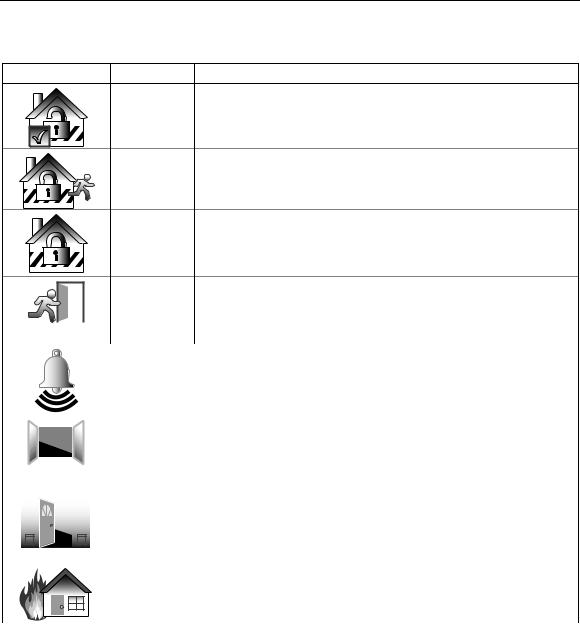
SYSTEM OVERVIEW
About the Display and Indicators
Display Definitions
ICON |
TEXT |
DEFINITION |
|
Ready to |
Displayed along with the the text “Ready To Arm” when |
|
Arm |
system is Disarmed and ready to arm. |
|
Armed |
“Armed Away” is displayed along the top of the screen. An |
|
Away |
armed away icon along with “Armed Away” is displayed after |
|
|
the exit delay expires. |
|
Armed Stay |
“Armed Stay” is displayed along the top of the screen. An |
|
|
armed stay icon along with “Armed Stay” is displayed after the |
|
|
exit delay expires. |
Exit Now
28 Seconds
“Armed Stay – Exit Now” or “Armed Away – Exit Now” is displayed in a red band along the top of the screen. An exit icon along with “Exit Now” and the time remaining (i.e.; “28 Seconds”) is displayed during the exit delay.
|
|
|
|
|
|
Alarm |
“Alarm” is displayed in a red band along the top of the screen. |
|
|
|
|
|
|
|
An alarm (bell) icon along with “Alarm” is displayed alternately |
|
|
|
|
|
|
|
with the Zone that has caused the alarm. |
|
|
|
|
|
|
|
|
|
|
|
|
|
|
Fault (Zone |
“Not Ready To Arm – Fault” is displayed in a yellow band |
|
|
|
|
|
|
No.& |
along the top of the screen. An open windowor door icon |
|
|
|
|
|
|
Description) |
along with the zone descriptor and “Window” or “Door” is |
|
|
|
|
|
|
||
|
OR |
|
displayed when a window or entry/exit fault has been |
||||
|
|
detected. |
|||||
|
|
|
|
|
|
|
|
|
|
|
|
|
|
|
OR |
|
|
|
|
|
|
|
|
|
|
|
|
|
|
|
Displayed alternately with the alarm (bell) icon and “Alarm”. |
|
|
|
|
|
|
|
|
|
|
|
|
|
|
|
“Alarm” is also displayed in a red band along the top of the |
|
|
|
|
|
|
|
|
|
|
|
|
|
|
|
screen. |
|
|
|
|
|
|
Fire OR |
The fire icon is displayed with alternating text “Fire” and “Fire |
|
|
|
|
|
|
Fire Alarm |
Alarm 95 Fire”. “Fire Alarm” is also displayed in a red band |
|
|
|
|
|
|
95 Fire |
along the top of the screen. |
|
|
|
|
|
|
|
|
|
|
|
|
|
|
|
|
– 12 –

|
|
|
|
|
|
|
|
|
|
|
|
|
SYSTEM OVERVIEW |
|
|
|
|
|
|
|
|
|
|
|
|
|
About the Display and Indicators |
|
|
|
|
|
|
|
|
|
|
|
|
|
|
|
|
|
ICON |
TEXT |
DEFINITION |
||||||||
|
|
|
|
|
|
|
|
|
|
|
|
Alarm 96 |
The Medical icon displayed when a medical alarm is activated. |
|
|
|
|
|
|
|
|
|
|
|
|
Medical |
“Alarm” is also displayed in a red band along the top of the |
|
|
|
|
|
|
|
|
|
|
|
|
|
screen. |
|
|
|
|
|
|
|
|
|
|
|
|
|
(If programmed for display by your installer) |
|
|
|
|
|
|
|
|
|
|
|
|
Alarm 99 |
The alarm (bell) icon when a burglary alarm is activated. |
|
|
|
|
|
|
|
|
|
|
|
|
Police |
“Alarm” is also displayed in a red band along the top of the |
|
|
|
|
|
|
|
|
|
|
|
|
|
screen. (If programmed for display by your installer) No |
|
|
|
|
|
|
|
|
|
|
|
|
|
display if 24 Hour Silent Response Type has been |
|
|
|
|
|
|
|
|
|
|
|
|
|
programmed. |
|
|
|
|
|
|
|
|
|
|
|
|
CO Alarm |
Displayed alternately with Carbon Monoxide when a CO alarm |
|
|
|
|
|
|
|
|
|
|
|
|
|
is activated. |
|
|
|
|
|
|
|
|
|
|
|
|
|
“CO Alarm” is also displayed in a red band along the top of the |
|
|
|
|
|
|
|
|
|
|
|
|
|
screen. |
|
|
|
|
|
|
|
|
|
|
|
|
Cover |
A check system icon along with “Cover Tamper” is displayed |
|
|
|
|
|
|
|
|
|
|
|
|
Tamper |
when a cover tamper has been detected. “Ready To Arm – |
|
|
|
|
|
|
|
|
|
|
|
|
|
System Trouble” is displayed in a yellow band along the top of |
|
|
|
|
|
|
|
|
|
|
|
|
|
the screen. |
|
|
|
|
|
|
|
|
|
|
|
|
Reporter |
The system has identified a problem with the telephone dialer. |
|
|
|
|
|
|
|
|
|
|
|
|
Failure |
|
|
|
|
|
|
|
|
|
|
|
|
|
|
|
|
|
|
|
|
|
|
|
|
|
|
|
Low |
“Not Ready To Arm – System Trouble” is displayed in a yellow |
|
|
|
|
|
|
|
|
|
|
|
|
||
|
|
|
|
|
|
|
|
|
|
|
|
Battery |
band along the top of the screen. A low battery icon along with |
|
|
|
|
|
|
|
|
|
|
|
|
||
|
|
|
|
|
|
|
|
|
|
|
|
|
“Low Battery” is displayed when the system’s backup battery |
|
|
|
|
|
|
|
|
|
|
|
|
|
|
|
|
|
|
|
|
|
|
|
|
|
|
|
power is low. |
|
|
|
|
|
|
|
|
|
|
|
|
90 RF Jam |
Appears when the system has detected an RF jamming |
|
|
|
|
|
|
|
|
|
|
|
|
|
condition or excessive interference. |
|
|
|
|
|
|
|
|
|
|
|
|
|
|
|
|
|
|
|
|
|
|
|
|
|
|
94 Phone |
Appears when the system has detected a loss of telephone |
|
|
|
|
|
|
|
|
|
|
|
|
Line Cut |
service. |
|
|
|
|
|
|
|
|
|
|
|
|
||
|
|
|
|
|
|
|
|
|
|
|
|
|
|
|
|
|
|
|
|
|
|
|
|
|
|
AC Loss |
Displayed when the system has lost AC power. “Ready To |
|
|
|
|
|
|
|
|
|
|
|
|
||
|
|
|
|
|
|
|
|
|
|
|
|
|
Arm – System Trouble” is displayed in a yellow band along the |
|
|
|
|
|
|
|
|
|
|
|
|
|
|
|
|
|
|
|
|
|
|
|
|
|
|
|
top of the screen. |
– 13 –

SYSTEM OVERVIEW
Navigating Menus
LCD Display
LYNX Touch’s Liquid Crystal Display (LCD) touch screen displays variable icons and text on “screens”. The screen displays status icons and associated text, the current time, system status information and menu choices. The system status is displayed in a colored band along the top of the screen. The band color is variable and will change between red, yellow and green as the system status changes.
The Menu area includes a list of commands, or choices that apply to the current selection. The status area provides information about various system events. A Security Home Screen or a “Dashboard Screen” is displayed whenever power is applied to the system. In addition the Green (Ready) LED will be lit.
Note: The displayed screens may vary slightly depending upon the devices and services that are installed in or connected to your system.
Dashboard Screen
If your system is connected to Total Connect Services the Dashboard Screen will be displayed. System Status is displayed at the top of the dashboard screen. The time, date and weather (as applicable) are displayed on the left third of the screen. Additionally five selection icons or “buttons” are displayed.
Note: Access to Text Messages, Weather, News and Traffic and other web content requires Total Connect Services. Ask your Installer, which of these features have been programmed in your system.
•Security – Provides access to Security Home Screen.
•Notices – Provides access to the Text Message Center
•Automation – Provides access to the Device and Z-Wave Home Automation Management screen.
•News – Provides access to News Updates
•Traffic – Provides access to Traffic Updates
•5-Day Forecast – Provides access to Local 5-Day Weather forecast
Ready To Arm
12:35 PM |
|
|
|
|
October 26, 2011 |
|
|
|
|
Mostly Sunny |
|
Security |
News |
Traffic |
|
|
|
|
|
68 F |
|
|
|
|
Feels Like 71 |
F |
72 |
|
|
|
|
|
|
|
5-Day Forecast |
Automation |
Notices |
|
|
|
|
|
||
5100-100-001-V1
LYNX Touch Dashboard Screen (Typical)
– 14 –

SYSTEM OVERVIEW
Navigating Menus
Navigation Keys
Navigating through the screens is accomplished by lightly touching the menu item on the touch screen. Once activated, the control will take you to the next screen. Selecting the “Home” (cancel) key will return you to the dashboard at any time unless System Programming mode is active. Pressing the or the “2” Key will return you to the previous screen.
Note: You may find it convenient to adjust the volume setting before entering the Program (Tools) Mode. This will allow you to clearly hear the feedback announcements or system beeps in the Programming Mode, of the system’s built-in speaker. To adjust the volume, select “More” on the “home Screen” and then select “Settings”. Adjust the volume using the slide shown on the Settings screen and then select “Save” to accept.
Function Keys
Four Function Keys allow you to quickly access Panic functions, army the system in Away mode, disarm the system and reurn to the home screen.
SYSTEM |
Ready To Arm |
|
|
STATUS |
|
|
|
SYSTEM/ZONE |
|
|
72 |
STATUS |
|
|
|
|
|
Zones |
Automation |
Arm Away |
Arm Stay |
Message |
Phone |
Delay |
10:18 AM June 8, 2010 |
More |
|
LEDs |
|
|
|
FUNCTION |
|
|
|
KEYS |
|
|
|
|
|
|
5100-100-073-V0 |
LYNX Touch Security Home Screen (page 1)
– 15 –

SYSTEM OVERVIEW
Navigating Menus
Menu Screens
System Status is displayed at the top of each screen. The time and date are displayed at the bottom of the Home Screen.
Menus
Unrestricted Menu
The first page of the Home Screen provides access to an Unrestricted Menu displays the system status and eight selection icons or “buttons”.
•Zones – Provides access to Zone information and options.
•Automation – Provides access to the Home Automation features.
•Arm Away – Used to Arm the system in Away mode.
•Arm Stay – Used to Arm the system in Stay mode.
•Message – Provides access to Message Center.
•Phone – Provides access to Speaker Phone mode (if programmed).
•Delay/Instant – Used to toggle between exit delay and instant arming options.
•More – Advances system to second page of the Home Screen.
The second page of the Home Screen displays the system status in and seven options.
•System – Provides information about system status.
•Tools – Provides access User Programming Menus (Master User Code required for access).
•Arm Away – Used to Arm the system in Away mode.
•Arm Stay – Used to Arm the system in Stay mode.
•Dashboard – Returns the system to the Dashboard screen. This icon is only displayed if your system is connected to Total Connect Services.
•Settings – Provides access to various touch screen functions including Brightness, Contrast, Volume, Voice, Chime and Ringer.
•Delay/Instant – Used to toggle between exit delay and instant arming options.
•Back – Returns system to first page of the Home Screen.
– 16 –

SYSTEM OVERVIEW
Navigating Menus
Master Menu
The User Menu provides access to User configurable features and displays eight options. Entering the Master User Code is required to access the Master menu.
•Users – Allows Master User to add or remove User Codes.
•Events – Allows Master User to view system events.
•Test – Allows Master User to Test the system.
•Keypad – Allows Master User to enroll and view information associated with Mobile Interface Device(s).
•Date Time – Used to program date and time.
•Reminders – Allows Master User to add or remove local and “Follow Me” reminders.
•Slide Show – Allows Master User to select a slide show for use as a screensaver.
•WiFi Config – Provides access to WiFi Configuration screen (requires the installation of a WiFi Communication Module).
•Back – Returns system to first page of the Home Screen.
Ready To Arm
Users |
Events |
Test |
Keypad |
Date Time |
Reminders |
Slide Show |
WiFi Config |
Back
5100-100-006-V0
– 17 –

SECURING THE PREMISES
System Status
General Information
Before arming your system, all protected doors, windows, and other protection zones must be closed or bypassed (see the BYPASSING PROTECTION section).
Ready LED: The Green (Ready) indicator on the control will be lit if the system is ready to be armed. If blinking, the system is not ready.
NOTE: The phrases shown in brackets are variable, and are announced only if appropriate in the current state of the system.
Depending on the current state of the system the following phrases may be heard:
fire alarm [zone voice descriptors]
carbon monoxide alarm [zone voice descriptors] alarm [zone voice descriptors]
fire fault [zone voice descriptors]
carbon monoxide fault [zone voice descriptors] fault [zone voice descriptors]
low battery [zone voice descriptor] system low battery
check system AC loss
zones bypassed chime
VOLUME LEVEL: The volume level of system announcements can be increased or decreased. Refer to the MESSAGE RECORDING/PLAYBACK section for the procedure.
System Can Be Armed
The Green Ready LED will be lit steadily once all protection zones have been closed or bypassed. You may now arm the system.
– 18 –
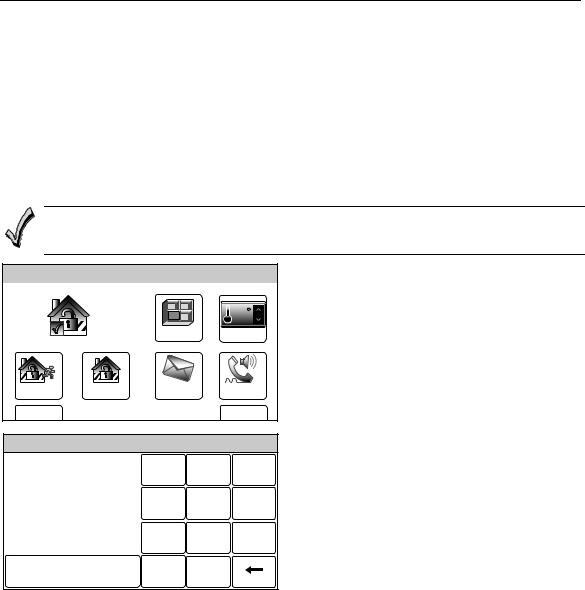
SECURING THE PREMISES
Arming the System
Arming in Stay Mode
Use this mode when you are staying home, but expect someone to use the entrance door later. Close all protected perimeter windows and doors before arming. The green Ready indicator on the control should be lit if the system is ready to be armed. When armed in STAY mode, the system will sound an alarm if a protected door or window is opened, but you may otherwise move freely throughout the premises. Late arrivals can enter through the designated entrance door without causing an alarm, but they must disarm the system within the entry delay period or an alarm will occur. If Quick Arm was programmed by the installer, you do not need to enter the security code to arm the system. The security code must always be used to disarm the system, however.
The Babysitter Code and Installer Code cannot disarm the system unless it was used to arm the system. In addition, if the system is armed by pressing via Quick-Arming, neither the Babysitter Code nor Installer Code can disarm the system.
Ready To Arm
|
|
|
|
72 |
|
|
Zones |
|
Automation |
Arm Away |
Arm Stay |
Message |
|
Phone |
Delay |
10:18 AM June 8, 2010 |
|
More |
|
|
|
|
|
5000-100-006-V1 |
|
Ready To Arm |
|
|
|
Arm the system in Stay mode |
1 |
2 |
3 |
|
|
|
|||
Enter Code: |
4 |
5 |
6 |
|
|
|
|||
|
|
7 |
8 |
9 |
|
Cancel |
Clear |
0 |
|
|
|
|
|
5000-100-137-V0 |
1.Select the Arm Stay icon, the system beeps once and displays a keypad.
2.Enter a valid User Code. OR
If Quick Arm has been enabled, select the “Quick Arm” icon.
The system beeps three times and announces “Armed Stay Exit Now”. The exit delay screen is displayed. If programmed the display counts down the time remaining in the exit delay.
Note: If a valid user code is not entered or the Confirm icon has not been selected within 10 seconds, the system returns to the “home” screen and it will not be armed.
– 19 –

SECURING THE PREMISES
Arming the System
Armed Stay |
3. |
At the end of the exit delay the system |
|
|
announces “Armed Stay” and displays |
|
72 |
the “Armed Stay” screen. |
|
|
|
Zones |
Automation |
|
Disarm |
Message |
Phone |
|
10:18 AM June 8, 2010 |
More |
|
|
5000-100-056-V1 |
If an invalid User Code is entered, the system will return to the home screen.
Auto Stay Feature
If this feature is enabled by installer, the LYNX Touch SIA, when armed AWAY from the control’s keypad or a Wireless Keypad, switches to the STAY mode if the Exit Time expires and no exit has been made.
NOTE: If the exit route entry/exit sensor is in a check condition or has been bypassed it will result in a loss of interior protection because the alarm system will arm STAY in this case. Consult with your installer for servicing of the entry exit zones or to turn off this feature if a check condition on entry exit zones occurs.
– 20 –
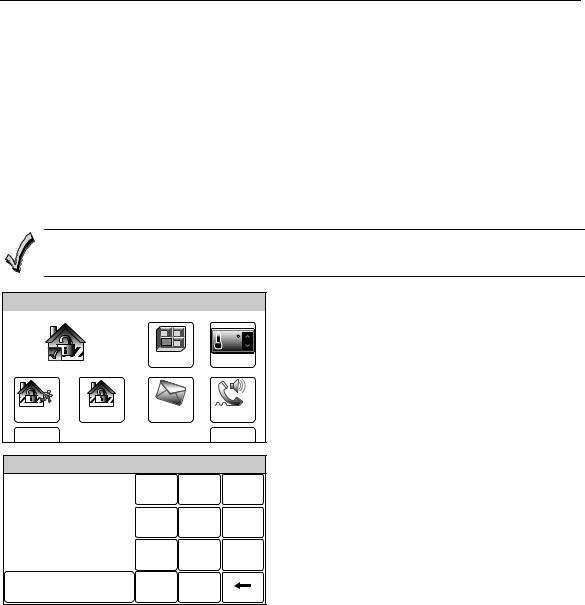
SECURING THE PREMISES
Arming the System
Arming In Away Mode
Use this mode when no one will be staying on the premises. Close all protected perimeter windows and doors before arming. The green Ready indicator on the control should be lit if the system is ready to be armed. When armed in AWAY mode, the system will sound an alarm if a protected door or window is opened, or if any movement is detected inside the premises, when infrared detection devices are used. You may leave through a designated entrance door during the exit delay period without causing an alarm. You may also re-enter through the entrance door, but you must disarm the system within the entry delay period or an alarm will occur. If Quick Arm was programmed by the installer, you do not need to enter the security code to arm the system. The security code must always be used to disarm the system, however.
The Babysitter Code and Installer Code cannot disarm the system unless it was used to arm the system. In addition, if the system is armed by pressing via Quick-Arming, neither the Babysitter Code nor Installer Code can disarm the system.
Ready To Arm
|
|
|
|
72 |
|
|
Zones |
|
Automation |
Arm Away |
Arm Stay |
Message |
|
Phone |
Delay |
10:18 AM June 8, 2010 |
|
More |
|
|
|
|
|
5000-100-006-V1 |
|
Ready To Arm |
|
|
|
Arm the system in Away mode |
1 |
2 |
3 |
|
|
|
|||
Enter Code: |
4 |
5 |
6 |
|
|
|
|||
|
|
7 |
8 |
9 |
|
Cancel |
Clear |
0 |
|
|
|
|
|
5000-100-053-V0 |
1.Select the Arm Away icon, the system beeps once and displays a keypad.
2.Enter a valid User Code. OR
If Quick Arm has been enabled, select the “Quick Arm” icon.
The system beeps two times and announces
“Armed Away Exit Now. The exit delay screen is displayed. If programmed the display counts down the time remaining in the exit delay in seconds.
Note: If a valid user code is not entered or the Confirm icon has not been selected within 10 seconds, the system will return to the “home” screen and it will not be armed.
– 21 –

SECURING THE PREMISES
Arming the System
Armed Away
|
|
72 |
|
Zones |
Automation |
Disarm |
Message |
Phone |
|
10:18 AM June 8, 2010 |
More |
3.If “Exit Warning” has been enabled, the system will continue to beep throughout the exit delay. Rapid beeps will sound for the final 10 seconds of the delay period. At the end of the exit delay the system will announce “Armed Away” and displays the “Armed Away” screen.
5000-100-057-V1
If an invalid User Code is entered, the system will return to the home screen.
– 22 –

SECURING THE PREMISES
Arming the System
Arming the System with no delay (Instant)
Use “Instant” with Stay mode when you are staying home and do not expect anyone to use the entrance door. Use “Instant” with Away mode when the premises will be vacant for extended periods of time such as vacations, etc. When armed with “Instant”, the system will sound an alarm if a protected door or window is opened, including the entrance door. You may leave through the entrance door during the exit delay period without causing an alarm, but an alarm will sound as soon as someone reenters.
When armed “Instant” with Stay mode, the control beeps three times and displays the “Armed Stay Instant” message. In addition, the red Armed indicator lights and the system announces “Armed Stay Instant –exit now”.
When armed “Instant” with Away mode, the control beeps two times and displays the “Armed Away Instant” message. If Exit Warning is enabled the system beeps continuously for the duration of the exit delay. In addition, the red Armed indicator lights and the system announces “Armed Away Instant –exit now”.
To Arm the System with No Delay (Instant)
Ready To Arm
|
|
|
72 |
|
|
Zones |
Automation |
Arm Away |
Arm Stay |
Message |
Phone |
Delay |
10:18 AM June 8, 2010 |
More |
|
1.Select the “Delay” tab on the home screen. The icon “toggles” and “Instant” is displayed.
2.Arm the system in the “Stay” or Away” mode normally.
Note: The entry delay time is eliminated when “Instant” is selected.
5000-100-006-V1
Quick Exit
If active, you can restart the exit delay at any time after arming has been armed in Stay or Away mode by selecting the “Quick Exit” icon. This avoids having the user disarm then rearm the system after allowing someone to enter or exit. The system will re-arm once the exit delay expires.
Armed Stay
|
|
|
72 |
|
|
Zones |
Automation |
Disarm |
Quick Exit |
Message |
Phone |
|
10:18 AM June 8, 2010 |
More |
|
1.Select the “Quick Exit” icon to restart the exit delay.
Note: Quick Exit is active in Away mode when: Auto Stay mode is enabled and no entry/exit zone has been faulted during the exit delay period.
5000-100-060-V1
– 23 –

SECURING THE PREMISES
Entry/Exit Delays
Exit Delay
Exit delay begins immediately after arming the system, and gives you time to leave through the designated exit door without setting off an alarm. The system display will count down the time remaining in the exit delay, if programmed by your installer. If the system has been Armed Away, a slow beeping will sound throughout the exit delay period, if programmed by your installer. The exit door must be closed before the end of the exit delay. During the last 10 seconds of the exit delay fast beeps will sound as a warning that the delay time is nearing its end. The exit beeps cannot be silenced.
Restarting Exit Delay While System Armed
Ask your installer if this feature is active for your system. If active, you can restart the exit delay one time after arming in Stay or Away mode during the exit delay by selecting the “Restart” key. This will allowing extra time for someone to enter or exit or re-enter the property before the system is armed.
Armed Stay - Exit Now
Exit now |
72 |
28 seconds |
|
Zones |
Automation |
Disarm |
Restart |
Message |
Phone |
|
10:18 AM June 8, 2010 |
More |
|
5000-100-061-V1
Exit Alarms
To minimize false alarms sent to the alarm monitoring company, your system may have been programmed for this feature. Ask your installer if Exit Alarm is active for your system.
Whenever you arm the system, the exit delay begins. If an entry/exit door or interior zone is faulted when the exit delay ends (e.g., exit door left open), the system sounds an alarm and starts the entry delay timer. If you disarm the system before the entry delay ends, the alarm sound stops and the message “Alarm Cancelled is displayed, in the system bar. Additionally, Alarm and the faulted zone are displayed with their associated icons in the system/zone status area. No message is sent to the alarm monitoring company. To clear the exit alarm condition, the open zone must be secured. To clear the display, select the “Disarm” icon OR depress the “Off” key and then enter your security code.
If you do not disarm the system before the entry delay ends, and an entry/exit door or interior zone is still open, the alarm sound continues and an "exit alarm" message is sent to the alarm monitoring company. The message “Alarm Exit Error" is displayed, in the system bar. Additionally, Alarm and the faulted zone are displayed with their associated icons in the
– 24 –

SECURING THE PREMISES
Entry/Exit Delays
system/zone status area. The alarm will continue to sound until the system is disarmed or timeout ocurs. To stop the alarm, the system must be disarmed by selecting the “Disarm” icon OR depressing the “Off” key and then entering your security code. The message “Alarm Cancelled" is displayed, in the system bar, indicating that the alarm has been cancelled (if this feature is enabled by the installer). “Alarm” and the faulted zone continue to be displayed with their associated icons in the system/zone status area. To clear the display, select the “Disarm” icon OR depress the “Off” key and then enter your security code a second time. An exit alarm also results if an entry/exit door or interior zone is faulted within two minutes after the end of the exit delay.
Entry Delay
Entry Delays give you time to disarm the system when you re-enter through the designated entrance door. You must disarm the system before the entry delay period ends, or an alarm will occur. The control beeps during the entry delay period, reminding you to disarm the system. There are two entry delays (if programmed). The first is for your primary entrance and the second can be used for a secondary entrance, where a longer delay is required to walk to the control to disarm the system. You can also arm the system with no entry delay at all by selecting the “Delay” icon prior to arming the system. This will toggle the system to “Instant”, which can provide greater security while on the premises or while away for extended periods of time. See Arming the System section for procedure. See your installer for delay times programmed for your system.
Exit Delay: |
|
None, 15, 30, 45, 60, 90 seconds, 2 minutes |
Entry Delay 1: |
|
None, 15, 30, 45, 60, 90 seconds, 2 minutes |
|
||
Entry Delay 2: |
|
None, 15, 30, 45, 60, 90 seconds, 2 minutes |
|
||
|
||
LYNX Touch SIA Exit/Entry Delay Times |
||
Exit Delay: |
|
45, 60, 90 seconds, 2 minutes |
|
||
Entry Delay 1: |
|
30, 45, 60, 90 seconds, 2, 3, 4 minutes |
|
||
Entry Delay 2: |
|
30, 45, 60, 90 seconds, 2, 3, 4 minutes |
|
||
|
|
|
– 25 –
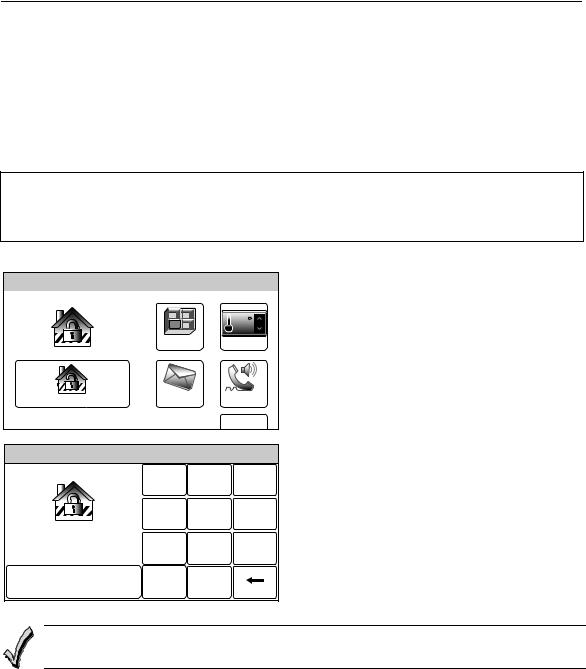
SECURING THE PREMISES
Disarming the System
Select the “Disarm” icon or the “Off” key to disarm the system and to silence alarm and trouble sounds. See the Summary of Audible Notification section for information, which will help you to distinguish between fire and burglary alarm sounds. During Entry Delay or when an Alarm Condition exists, the system will be disarmed as soon as the correct user code is entered on the touch screen. Selecting the Off key is not required. The entry beeps or alarm sound can be silenced by pressing any key however, it will restart in 10 seconds if the correct User Code is not entered. The Ready indicator will light (if no alarms have occurred while armed) and the control will beep once to confirm that the system is disarmed.
**IMPORTANT**
If the LYNX Touch is beeping rapidly upon entering the premises, an alarm has occurred during your absence and an intruder may still be on the premises. LEAVE IMMEDIATELY and CONTACT THE POLICE from a nearby safe location.
Disarming the System and Silencing Alarms
Armed Stay
|
|
|
72 |
|
Zones |
|
Automation |
Disarm |
Message |
|
Phone |
|
10:18 AM June 8, 2010 |
|
More |
|
|
|
5000-100-056-V1 |
|
Armed Stay |
|
|
|
1 |
2 |
3 |
|
4 |
5 |
6 |
Enter Code: |
7 |
8 |
9 |
|
|||
Cancel |
Clear |
0 |
|
|
|
|
5000-100-065-V0 |
1.Select the “Disarm” icon or depress the “Off” key. The system beeps once and displays a keypad.
2.Enter a valid Code. The system beeps once and announces “Disarmed Ready to Arm”.
Note: If a valid user code is not entered or the Confirm icon has not been selected within 30 seconds, the system returns to the “home” screen and it will not be disarmed.
If an invalid User Code is entered, system will return to the home screen.
– 26 –
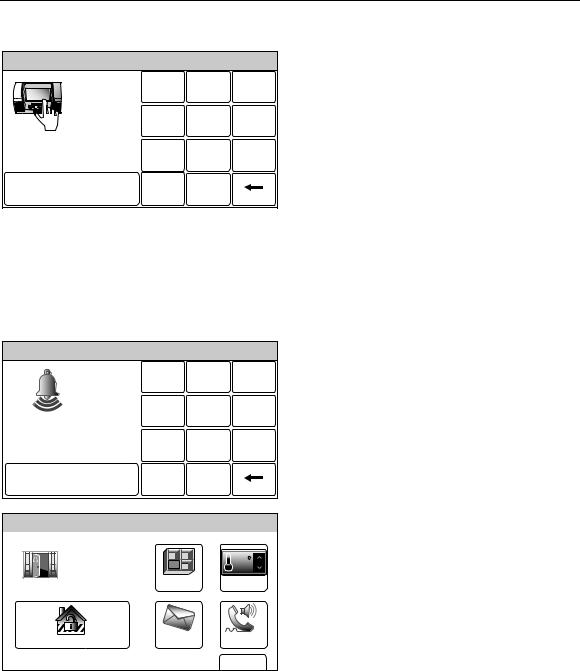
SECURING THE PREMISES
Disarming the System During Entry Delay
Armed Stay - Disarm Now |
|
||
Disarm Now |
1 |
2 |
3 |
|
|||
|
4 |
5 |
6 |
Enter Code: |
7 |
8 |
9 |
|
|||
Cancel |
Clear |
0 |
|
|
|
|
5000-100-201-V0 |
Disarming the System
Upon entering the premise when the system is armed, the control announces “disarm system now”.
1.Enter a valid Code. The system beeps once and announces “Disarmed Ready to Arm”.
Note: If a valid user code is not entered before the programmed entry delay occurs, the system enters alarm mode.
When an Alarm Occurs
When an alarm has occurred, the touch screen displays the zone number(s) that caused the alarm and the type of alarm (e.g., “Fire Alarm”). These messages remain displayed until cleared by a user. To clear the display, note the zone number displayed and enter an Off sequence. If the fault cannot be corrected, notify your alarm company.
Disarming the System and Silencing Alarms
|
Alarm |
|
|
Alarm |
1 |
2 |
3 |
|
|||
|
4 |
5 |
6 |
Enter Code: |
7 |
8 |
9 |
|
|||
Cancel |
Clear |
0 |
|
|
|
|
5000-100-202-V0 |
|
Alarm |
|
|
Alarm 2 |
|
Front Door |
72 |
|
Zones Automation
1.Enter a valid Code. The system beeps once and announces “Disarmed Ready to Arm”.
Note: If a valid user code is not entered before the programmed entry delay occurs, the system remains in alarm mode.
2.The zone that caused the alarm is displayed. Enter an Off sequence to clear the alarm. The system beeps once and announces “Disarmed Ready to Arm”.
Disarm |
Message |
Phone |
|
4:43 PM August 11, 2011 |
More |
|
|
5000-100-203-V1 |
– 27 –
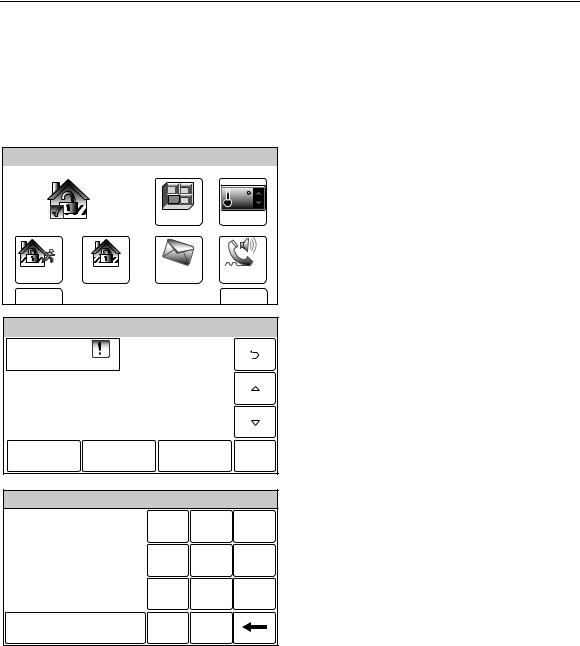
SECURING THE PREMISES
Bypassing Protection Zones
Bypassing Individual Zones
The Bypass feature can be used when you want to intentionally arm your system with one or more zones unprotected. Bypassed zones are unprotected and will not cause an alarm when violated while your system is armed. All bypasses are removed when an Off sequence is performed. The system will not allow panic, fire or CO zones to be bypassed.
Bypassing Zones
Ready To Arm
|
|
|
72 |
|
|
|
Zones |
Automation |
|
Arm Away |
Arm Stay |
Message |
Phone |
|
Delay |
10:18 AM June 8, 2010 |
More |
||
|
|
|
5000-100-006-V1 |
|
|
Not Ready To Arm - Fault |
|
||
2. Front |
|
|
|
|
Door |
FAULT |
|
|
|
|
|
|
||
Bypass All |
Clear |
Bypass |
Select |
|
Faulted |
Bypasses |
Fault |
||
|
||||
|
|
|
5000-100-141-V0 |
|
1.With the system in the disarmed state, select the “Zones” icon. The system displays the Zones/Bypass screen.
2.Select the zone(s) that you wish to bypass and then select “Bypass” OR if programmed, the “Bypass All Faulted” button allows you to bypass all faulted zones (excluding Panic, Fire or CO zones). The system displays a keypad.
Not Ready to Arm - Fault |
|
|
|
Bypass Selected Zones |
1 |
2 |
3 |
|
|||
Enter Code: |
4 |
5 |
6 |
|
|||
|
7 |
8 |
9 |
Cancel |
Clear |
0 |
|
|
|
|
5000-100-067-V0 |
3.Enter a valid Code. The system returns to the Bypass screen and the zone(s) that are bypassed will be displayed.
4.Select the 2 icon to return to the home screen.
5.Arm the system normally. See Arming the System section for the procedure.
– 28 –
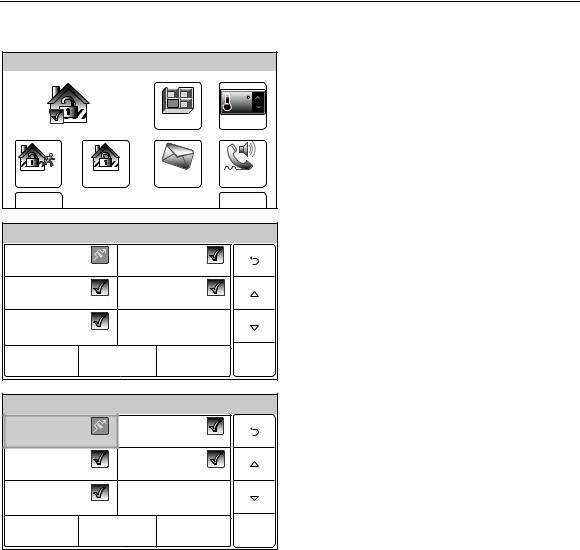
SECURING THE PREMISES
Displaying/Clearing Bypassed Zones
Ready To Arm - Bypass
|
|
|
|
|
72 |
|
|
|
|
Zones |
Automation |
||
Arm Away |
Arm Stay |
|
Message |
|
Phone |
|
Delay |
10:18 AM June 8, 2010 |
|
More |
|||
|
|
|
|
|
5000-100-210-V0 |
|
|
Ready To Arm - Bypass |
|
|
|||
2. Front |
|
3. Garage |
|
|
||
Door |
BYPASSED |
Door |
|
READY |
|
|
|
|
|
|
|||
95. Fire |
|
96. Medical |
|
|
||
|
READY |
|
|
READY |
|
|
99. Police |
|
|
|
|
|
|
|
READY |
|
|
|
|
|
Bypass All |
Clear |
Bypass |
Select |
|||
Faulted |
Bypasses |
All |
||||
|
|
|||||
|
|
|
|
|
5100-100-089-V0 |
|
|
Ready To Arm - Bypass |
|
||
2. Front |
3. Garage |
|
|
|
Door |
Door |
READY |
|
|
|
BYPASSED |
|
||
95. Fire |
96. Medical |
|
|
|
|
READY |
READY |
|
|
99. Police |
|
|
|
|
|
READY |
|
|
|
Bypass All |
Clear |
Bypass |
Select |
|
Faulted |
Bypasses |
All |
||
|
||||
|
|
|
5100-100-090-V0 |
|
Bypassing Protection Zones
1.With the system in the disarmed state, select the “Zones” icon. The system displays the Zone screen and the status for each zone will be indicated.
2.Use the “S” “T” buttons to scroll to additional pages and view the zone status.
3.If you select the “Select All” button it scrolls through the following: “Select All”, “Select Alarm”, “Select Trouble” and “Select Fault”. The system displays the associated zones.
Note: If one or more zones has been bypassed the “Clear Bypasses” button will be highlighted.
4.To clear the bypass, select the zone(s) that are bypassed, then select the “Clear Bypasses” button.
5.Enter a valid code on the displayed keypad. The system returns to the Zones screen.
6.Select the 2 icon to return to the home screen.
– 29 –
